On Monday 26th February, members and friends of the Melbourne Section of the AES gathered at the Wellington St campus of Collarts to hear Game Sound Designer Stephan Schutze present on the topic of:
Game audio asset collection, production and management
The event was also live-streamed on our YouTube channel for those unable to attend.
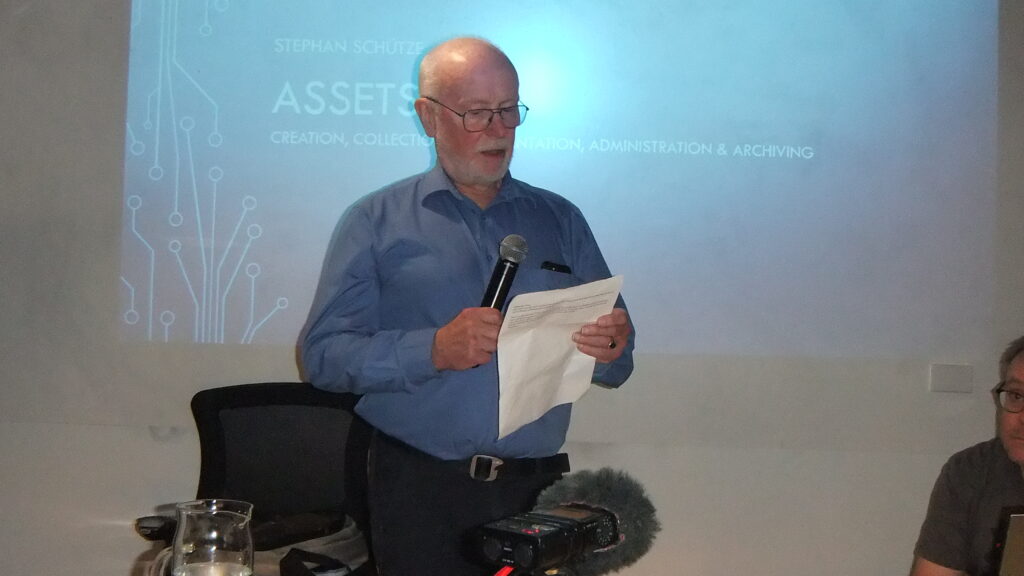

After a brief introduction from Section Chairman Graeme Huon, Stephan started his presentation by explaining that his formal education was as an instrumental musician, with 5 years in the Army band as a musician, followed by a second university music course. He indicated that none of this prepared him for his ultimate career as a sound designer, stating that he is entirely self-taught in this discipline. He started at the deep end with a small games company where he had to create the sound effects, compose the music, and edit the voiceovers and videos, as well as balance all the player character stats for an upcoming title. He recounted how it was a steep learning curve in a low-budget environment where resources were limited. He described creating effects by recording live sounds and layering the recordings for the desired effect.
Stephan indicated that during this time he learned how to use Cool Edit (the forerunner to Adobe Audition) and noted that its simplicity of operation means he still uses it for some tasks today, seeing no need to update to the more complex successors.
His next project for this company required the creation of music assets as well as effects, and recounted the experience of graduating from creating music using a (rather primitive) sample library to recording his compositions with the Melbourne Symphony Orchestra – having to pick up the skills as he went.
He went on to discuss the importance of asset management and naming conventions and then moved on to discuss the recording hardware he has used over the years espousing his philosophy of using the minimal equipment needed to do the job – starting with an early Edirol solid-state recorder to supplement the contemporary DAT recorders, then moving on to the early Zoom models. He indicated that the superior performance of more expensive devices was often unnecessary given the high SPL levels of the sounds being captured, and the small size and almost disposable nature of these devices allowed them to be used in circumstances where using his more bulky and expensive devices would be unthinkable.
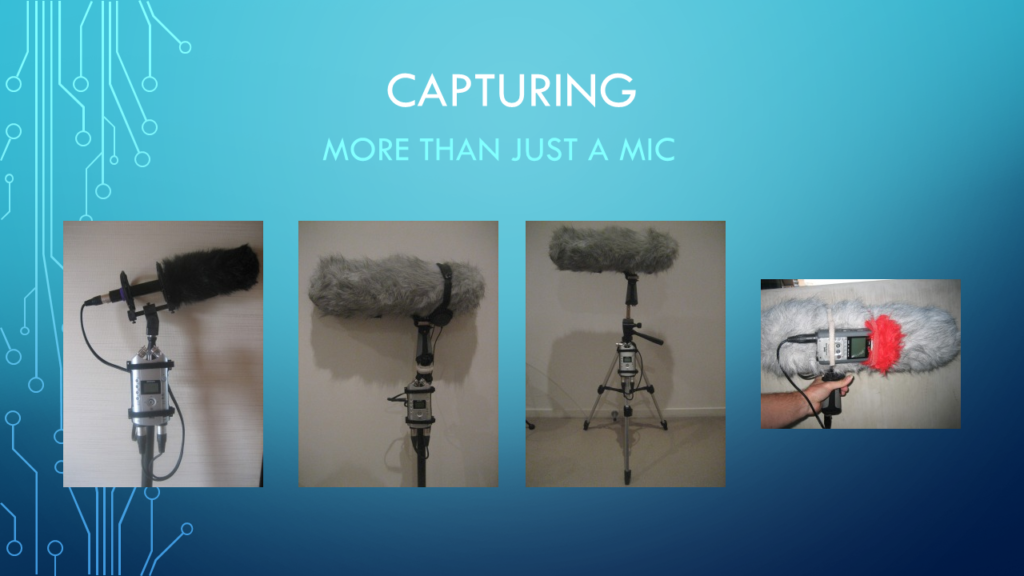
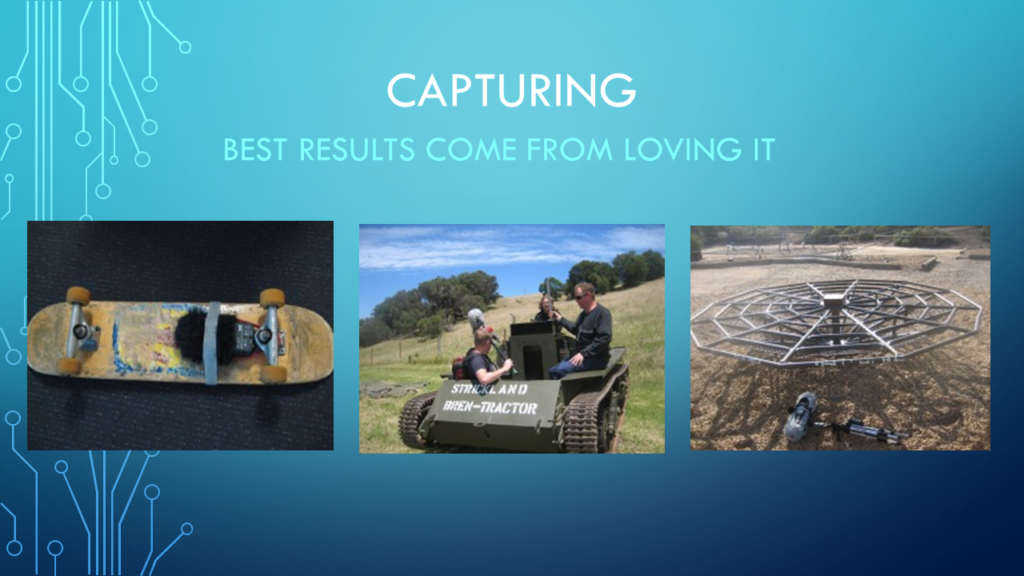
He then briefly discussed the rigging of the equipment for various capture examples, including ones where more high-performing and bulky equipment would not be viable, like the flight suit pocket of a Spitfire pilot or the underside of a skateboard. He displayed various of these devices as he spoke of their use.
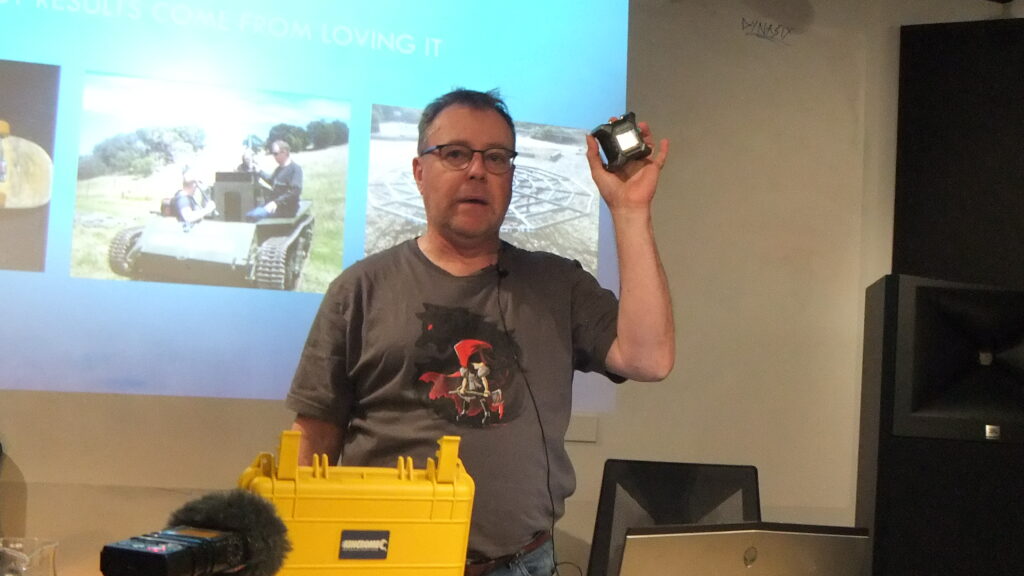
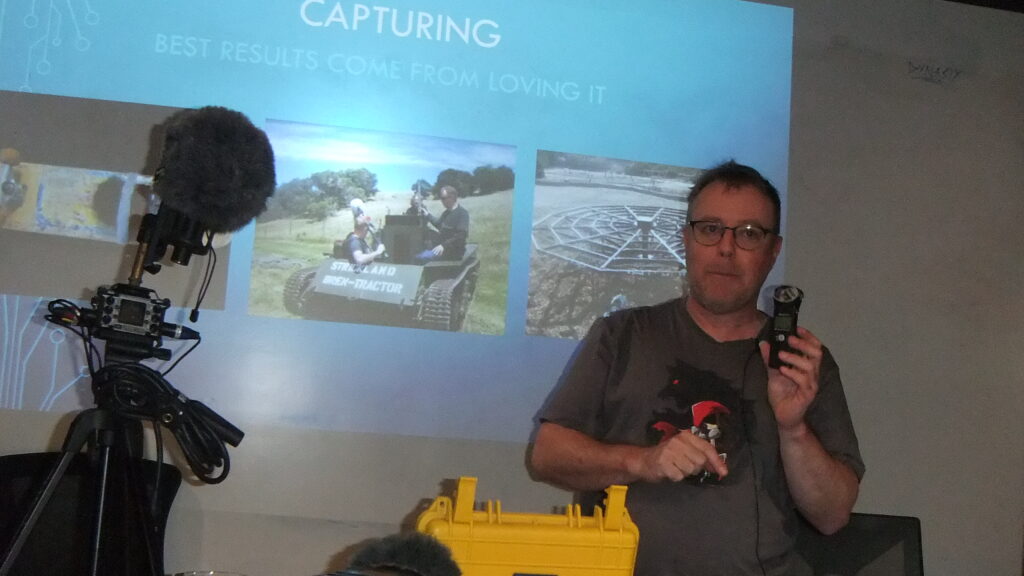
To wrap up this discussion he introduced us to his latest Zoom 32-bit recorders, the F3 and F6 and characterised the move to 32-bit recording as revolutionary given the wide dynamic range of the sounds he is often capturing. He commented that, given the amount of post-production processing and layering that is applied to his effects the superior sonic performance of the more expensive recorders is unwarranted, particularly given the disadvantage of their bulk. He also commented that the sonic performance of the current crop of Zoom products was very good indeed.
Stephan then recounted some experiences with field recording of sounds and effects and noted how he always had to be open to finding new sounds when out in the field. He recounted the experience of being out in the field to record bird sounds but finding a children’s playground roundabout with a unique-sounding squeak, he found himself recording many variations of it for stock effects, which ended up being layered into a spaceship sound effect on an international production.
He then briefly covered the range of formats in which he recorded sounds – from mono, through stereo to surround and ambisonic and high bitrate/bit-depth formats right up to 192kbps-32-bit. He commented that with the current microphone state-of-the-art achieving 100kHz audio bandwidth (eg Sanken CO-100K) you need at least 192kHz sampling to record the full spectrum that the mic captures, and the extended dynamic range of 32-bit accommodates the full range of practical SPL without the worry about clipping.
He then covered the naming conventions he uses for sound files, as well as the now-standardised Universal Sound Categories system (USC) which he also uses for his projects. He then briefly covered the search tools used such as Soundminer and BassHead as well as the built-in search tools in DAWs like Nuendo and Reaper, commenting that he finds the DAW built-in tools suitable for all but the most complex sound libraries.
He then covered curating and archiving, warning that CD-R discs are not a long-life medium and any sounds stored on them should be transferred to hard disk ASAP. He recounted a bad experience with a NAS drive (simultaneous loss of two drives causing major data loss) has caused him to now rely on duplicated multiple portable hard drives and a rigourous backup reqime. He also commented that the sheer amount of data involved made cloud storage currently too expensive for his operation.
He then covered implementation, highlighting the fact that audio for game-play is a real-time process. There is no downmixing – it all occurs during gameplay requiring the assets to be flexible enough to cover most possibilities of differing gamer input.
He went on to speak of the emotional impact that properly designed music and effects can have on audiences when used thoughtfully, encouraging the audience to be mindful of this in their work.
A Q&A session followed his presentation covering topics as broad as the techniques of layering the effects within the DAW, the process of capturing firearm effects and limited access to firearms in Australia (US sources have easier access to a wider range of firearms). He was also asked where beginners should go if looking to break in – he suggested tapping into the community. He specifically mentioned IGDAM and recommended attending regular GameJam events. He was asked about his experiences recording aircraft at Temora (Warbirds Down Under) and Tyabb airshows. He was also quizzed about the opportunities in Australia vs overseas – commenting that while there is a lot of good work being done in Australia, there are many more opportunities in the US, and Australians are well-regarded there, so he suggested that course.
The AES Melbourne Section thanks Stephan for a most passionate, interesting, and informative presentation.
We also thank Jason Torrens and Will Petts from the Collarts Wellington Street Campus for providing both the venue and the technical facilities and expertise for recording and streaming the event.
Here’s an edited video of the YouTube stream:
This video can be viewed directly on YouTube at:
https://youtu.be/t9k0F8WR9dM
A PDF of Stephan’s slides is available at:
https://www.aesmelbourne.org.au/wp-content/media/AES_Feb24_ASSETS.pdf
Related Links:
Stephan Schutze:
http://www.stephanschutze.com/
https://www.soundlibrarian.com/
Zoom 32-bit Field Recorders:
https://zoomcorp.com/en/jp/field-recorders/field-recorders/f3/
https://zoomcorp.com/en/jp/field-recorders/field-recorders/f6/
Sanken 100kHz Shotgun mic: https://sankenchromatic.com/products/co-100k/
Search Tools:
Soundminer: https://store.soundminer.com/
Base Head: https://baseheadinc.com/
Community: IGDA Melbourne https://igdamelbourne.au/

